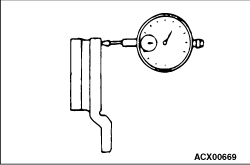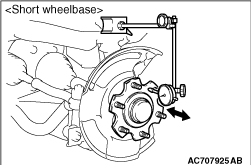|
|
1.Remove the brake assembly, and then hold it with wire.
|

|
2.Place a dial gauge approximately 5 mm from the outer circumference of the brake disc,
and measure the run-out of the disc.
Limit: 0.06 mm or less
|


|
3.If the brake disc run-out exceeds the limit, correct it as follows:
(1)
Chalk phase marks on the wheel stud and the brake disc, which run-out is excessive
as shown.
(2)
Remove the brake disc. Then place a dial gauge as shown, and measure the axial play by
pushing and pulling the wheel hub.
Limit: 0 mm <Front>, 0 mm <Rear>
(3)
If the axial play exceeds the limit, disassemble the hub and knuckle assembly to check
each part.
(4)
If the axial play does not exceed the limit, dephase the brake disc and secure it.
Then recheck the brake disc run-out.
4.Remove the brake assembly, and then hold it with wire.
|

